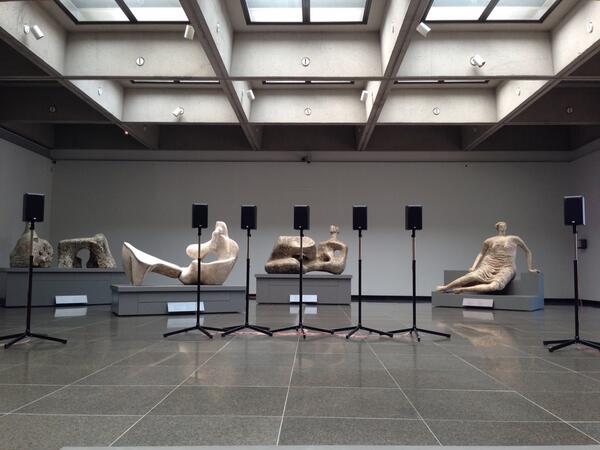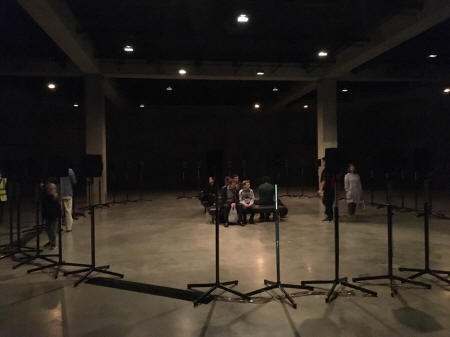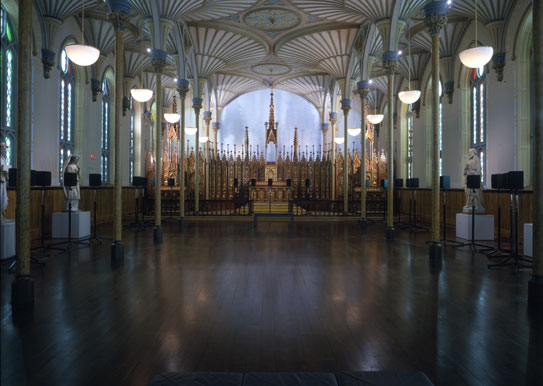|
|
| home | exhibitions | interviews | features | profiles | webprojects | archive |
|
Motet Martin Holman Martin Holman responds to Janet Cardiff’s Forty Part Motet at Richmond Chapel, Penzance
‘What we'll do is we'll go through it one more time — we’ll really go for it and then we'll give you a little break, a breather,’ says the choirmaster to the singers. They are performing ‘Spem in Alium’, the motet by the Tudor composer Thomas Tallis. Their banter and humming, laughs and throat-clearing are overheard in the almost bare interior of the Richmond Chapel in Penzance. But, apart from the people eavesdropping on these conversations, there is no other person in the room. Moreover, the words they hear were spoken almost 18 years earlier. The choir is invisible and their voices disembodied because the people present in the chapel are hearing a recording. It was made in another place in 2000, and the chatter fills the interval between takes. Janet Cardiff left that part in when members of Salisbury Cathedral Choir sang especially for her project, Forty Part Motet. This audio installation plays physical emptiness off against perceived wholeness. Even when the singing stops, the space it leaves seems full. ‘I am interested in how audio affects our perception of the physical world,’ the artist has said and the experience it offers is as much an intellectual encounter with the potency of immaterial sound to reshape viewpoints as it is with Tallis’s sensual masterpiece. In its delivery, Cardiff manages to immerse her audience in an awareness of both.
The setting also changes the sound. The porch and door to Richmond Chapel disconnect the panoramic possibilities of art from the tones of everyday reality. The building, a redundant Methodist foundation that, after almost a decade of closure, is coming back into community use, is a few minutes by foot from the town centre, where the hubbub of commerce gives over to relative peace of residential streets. Inside the single space is lofty in height and, in the Wesleyan manner, unencumbered by lavish adornment. The intrusion of ribbons of Catholic-inspired polyphonies must have rocked its foundations – a contextual conundrum supplied by the organisers and not foreseen by the artist. Location, function and acoustics play have their part in the work as much as the score: a Berlin tonmeister tunes the music precisely as part of every installation. Cardiff is a Canadian whose principal material is sound. It flows through speakers or headphones in a mobile current that reverberates through the inner and outer spaces that her audiences occupy. The intimacy of the encounter possesses the strength to reshape momentarily each person’s perception of his or her surroundings. Huge, sculpted melodic lines wash through the space. It is not surprising, then, that we talk of sound as travelling in waves. Speaking at the time she was completing Forty Part Motet, Cardiff said that ‘…one of the main things about my work is the physical aspect of sound. A lot of people think it’s the narrative quality, but it’s much more about how our bodies are affected by sound. That’s really the driving force.’ That distinctly aural experience unfolds layers of possibility that cannot be fully anticipated at the outset. Her work benefits from the postwar dilution of boundaries both in genres of creativity and in public expectation of the forms that art can legitimately assume. Against that background, she exploits the three-dimensionality of sound to reveal degrees of transference between physical and imaginative spaces. Sound has a plastic intensity: it models states of feeling and being. In the process, the visitor switches from observer to participant in the craft of making. The motet that Cardiff chose was composed at some point in the third quarter of the sixteenth century. Motets have a late medieval origin and are traditionally scored only for voices. They are structured around a text; indeed, the term itself may derive from the French ‘mots’ or words. By the Renaissance, which was Tallis’s time in Reformation England, motets achieved a highly elaborate form of interlacing vocal patterns and it is possible to imagine the most masterful composers vying with each other across Europe to outdo rivals in the extent and harmonic resonance of their polyphony.
As this pattern repeats, the listener tracks the passage of sound as it moves one way round the ring and then in the reverse direction. Tallis may originally have seated the audience within the choir to absorb this acoustic geometry in motion, with voices coming from behind, from the sides and in front. A scholarly theory maintains that the framework of rhythms derived from the octagonal double-height space where the motet was first performed in London. This was most likely a grand private residence owned by the Catholics who commissioned it in Elizabeth’s Protestant England. The hall there had an upper gallery with the implication that Tallis planned a vertical dimension, with choirs on two (or more) levels. The pulse of voices, therefore, may have originally moved between above and below as well as from side to side, showering the room in a cascade of musical ideas. As Cardiff researched the sound and written score of the piece, she must have been struck by their explicit spatiality, above all the hypothesised space for motifs to evolve, turn and change. Cardiff has explored multiple simultaneous spatial experiences by orchestrating sound in a sculptural way since the early 1990s. Her continuing series of ‘audio walks’ superimpose a virtual itinerary on top of a real setting which her listeners are walking through in person. All the while the artist provides a commentary of directions, thoughts and storylines through headphones. Actual experience combines with an alternative, recorded reality in parallel time. Spaces seamlessly multiply and co-exist. In the Forty Part Motet music takes the place of her recorded commentaries. Speaking about her modelling of the motet, the artist has talked about inviting listeners to ‘climb inside’ the music, ‘… so as you listen, you’ll be walking through this sound piece.’ The Latin text sung is one of the September readings in the daily service of Matins and extols God as the only hope of mankind. It is unlikely that many people entering Cardiff’s soundscape will know this Biblical extract. More will be familiar with Tallis’s composition as it is regarded as the English composer’s greatest musical achievement. It still features in the choral repertoire and there will be those visiting who have sung parts in it. Others may have attended a performance where, seated in the stalls or galleries, they have fantasised about taking part. Alone in this installation, in spite of being aware of the people with whom they are sharing the space, they can pursue that fantasy vicariously, adopting new identities for the duration, shifting back and forth between memory and imagination. Inside the chapel, the room is open to that possibility. It is almost bare except for a cluster of church pews tidied into the chancel, some restrained painted decoration in the tall windows and 40 box-like black speakers. The speakers are set out in an ellipse. More circular than oval, the shape spans out across the simple wood floor of the nave, almost touching on two sides walls from which old plaster occasionally peels. Each one perches at head-height on identical slim metal uprights supported by splayed feet. Their appearance is strangely anthropomorphic; erect and closely spaced in groups of five, they look at pains to avoid treading on their neighbours. The gaps between them admit people to the centre of the ring where two benches are placed. Above this spare assembly hangs the extraordinary Edwardian ceiling of dark, hammer-beam trusses and metal tie rods. And the speakers sing.
So there are no restrictions on how visitors place themselves within the oval. The assumption designed into the lay-out is that as well as sitting or standing, they will walk the inner perimeter of speakers and stand close to voices, because the singers are not there. In this way, they sample the different vocal types, and hear breath and silences as fully as they absorb the music. By following the trajectory of sound, listeners insert themselves into the making of the piece and, as Cardiff has explained, ‘experience a piece of music from the viewpoint of the singers. Every performer hears a unique mix…’ One remarkable feature of this environment is the depth of individual experience it sanctions in a public place. ‘I have witnessed visitors clutching their chests, wiping away tears, or just smiling wistfully up at the frescoes as they become immersed in the moment,’ wrote an observer at one New York museum venue. Those words could equally describe a trauma as a stirring performance, and it is not unusual for visitors to describe the experience as a dreamscape in which two parallel states co-exist – when simultaneously the body is in one place and the mind is somewhere else. Tallis’s motet induces a response that is often described generically as ‘spiritual’ or, equally otherworldly but more secular, as ‘ethereal’. Its first setting was the Victorian Rideau chapel in Ottawa which, because of its rich interior decoration, was rebuilt in the National Gallery of Canada on the ground of cultural merit when its building was demolished. That choice did not mean Cardiff intended her sound piece to be a ‘religious’ artwork any more than a live rendition in a concert hall becomes a form of worship. Nonetheless, context is an obvious element in the work’s reception, drawing out individual memories and associations. Transferring the piece to secular locations does not diminish its impact; it merely modifies it.
Cardiff’s strategy of substituting a recording for a live recital in situ constitutes an important layer in this work’s unravelling significance. The choice had obvious practical advantages; after all, the piece plays continually in Penzance for seven hours, six days a week over three months. Nonetheless the incongruity of presenting artificial technology as the medium for this encounter with natural accomplishment s inescapable – and credibly part of Cardiff’s purpose. Many people now listen to music alone, piped from mobile phones and similar devices into earpieces that offer unprecedentedly intimate absorption in a favourite track or selection, or in talk radio and the 24-hour news cycle that transports the listener here and there – to Afghanistan, Syria or the White House press room. That access is regularly sought in public places and provides a porous barrier between distinct spaces that mind and body occupy in the same moment as fertile ground for the imagination. This experience of being remote and connected is an emblem of modern existence. Technology is now as indispensable as nature; both separate and connect. The title, perhaps coincidentally, seems to underline that particularisation by stressing the number of independent singers, each of whom is custodian of the music’s internal comprehensibility. Listeners arrive at any point in the continuously looped recitals and leave when they want. Having taken the motet apart, voice by voice and line by line, Cardiff makes it possible, should someone chose it, to assemble the piece afresh, to make it more their own. Technology is now as indispensable as nature; both separate as much as they connect. That ‘unique mix’ renders everyone, potentially, their own author. Left hanging in the air as evocatively as the memory of Tallis’s last note is the installation’s ambivalence about the advantage of this technical ingenuity. Forty Part Motet, like so much of Cardiff’s production, implies the essential fluidity of each individual’s relationship with the world. Conceivably, that same fluidity extends to individual identity; fractured between spaces that are real and fictive, each person is the sum of transposable parts. Just as Tallis’s music is available to reconstruct within the installation, identities combine and unravel, travel and evolve outside it. Maybe that is the nature of life now. Cardiff looks around for the instruments by which people can consider that possibility. The music is an analogy of ourselves: shifting and precarious in form, and capable of great beauty. Forty Part Motetderives its provocative strength from the enduring potency of imagination rather than the ephemeral sensations of the digital fairground.
Martin Holman is a writer based in Penzance © 2018 Janet Cardiff’s Forty Part Motet was at Richmond Chapel, Penzance 25 May – 27 August 2018 as part of Groundwork, a season of exhibitions and events by international artists in Cornwall, organised by CAST in association with Newlyn Art Gallery. 2/8/18 |
|
|



